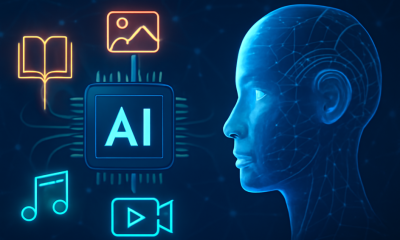Artificial General Intelligence
The Evolving Landscape of Generative AI: A Survey of Mixture of Experts, Multimodality, and the Quest for AGI

The field of artificial intelligence (AI) has seen tremendous growth in 2023. Generative AI, which focuses on creating realistic content like images, audio, video and text, has been at the forefront of these advancements. Models like DALL-E 3, Stable Diffusion and ChatGPT have demonstrated new creative capabilities, but also raised concerns around ethics, biases and misuse.
As generative AI continues evolving at a rapid pace, mixtures of experts (MoE), multimodal learning, and aspirations towards artificial general intelligence (AGI) look set to shape the next frontiers of research and applications. This article will provide a comprehensive survey of the current state and future trajectory of generative AI, analyzing how innovations like Google's Gemini and anticipated projects like OpenAI's Q* are transforming the landscape. It will examine the real-world implications across healthcare, finance, education and other domains, while surfacing emerging challenges around research quality and AI alignment with human values.
The release of ChatGPT in late 2022 specifically sparked renewed excitement and concerns around AI, from its impressive natural language prowess to its potential to spread misinformation. Meanwhile, Google's new Gemini model demonstrates substantially improved conversational ability over predecessors like LaMDA through advances like spike-and-slab attention. Rumored projects like OpenAI's Q* hint at combining conversational AI with reinforcement learning.
These innovations signal a shifting priority towards multimodal, versatile generative models. Competitions also continue heating up between companies like Google, Meta, Anthropic and Cohere vying to push boundaries in responsible AI development.
The Evolution of AI Research
As capabilities have grown, research trends and priorities have also shifted, often corresponding with technological milestones. The rise of deep learning reignited interest in neural networks, while natural language processing surged with ChatGPT-level models. Meanwhile, attention to ethics persists as a constant priority amidst rapid progress.
Preprint repositories like arXiv have also seen exponential growth in AI submissions, enabling quicker dissemination but reducing peer review and increasing the risk of unchecked errors or biases. The interplay between research and real-world impact remains complex, necessitating more coordinated efforts to steer progress.
MoE and Multimodal Systems – The Next Wave of Generative AI
To enable more versatile, sophisticated AI across diverse applications, two approaches gaining prominence are mixtures of experts (MoE) and multimodal learning.
MoE architectures combine multiple specialized neural network “experts” optimized for different tasks or data types. Google's Gemini uses MoE to master both long conversational exchanges and concise question answering. MoE enables handling a wider range of inputs without ballooning model size.
Multimodal systems like Google's Gemini are setting new benchmarks by processing varied modalities beyond just text. However, realizing the potential of multimodal AI necessitates overcoming key technical hurdles and ethical challenges.
Gemini: Redefining Benchmarks in Multimodality
Gemini is a multimodal conversational AI, architected to understand connections between text, images, audio, and video. Its dual encoder structure, cross-modal attention, and multimodal decoding enable sophisticated contextual understanding. Gemini is believed to exceed single encoder systems in associating text concepts with visual regions. By integrating structured knowledge and specialized training, Gemini surpasses predecessors like GPT-3 and GPT-4 in:
- Breadth of modalities handled, including audio and video
- Performance on benchmarks like massive multitask language understanding
- Code generation across programming languages
- Scalability via tailored versions like Gemini Ultra and Nano
- Transparency through justifications for outputs
Technical Hurdles in Multimodal Systems
Realizing robust multimodal AI requires solving issues in data diversity, scalability, evaluation, and interpretability. Imbalanced datasets and annotation inconsistencies lead to bias. Processing multiple data streams strains compute resources, demanding optimized model architectures. Advances in attention mechanisms and algorithms are needed to integrate contradictory multimodal inputs. Scalability issues persist due to extensive computational overhead. Refining evaluation metrics through comprehensive benchmarks is crucial. Enhancing user trust via explainable AI also remains vital. Addressing these technical obstacles will be key to unlocking multimodal AI's capabilities.
Assembling the Building Blocks for Artificial General Intelligence
AGI represents the hypothetical possibility of AI matching or exceeding human intelligence across any domain. While modern AI excels at narrow tasks, AGI remains far off and controversial given its potential risks.
However, incremental advances in areas like transfer learning, multitask training, conversational ability and abstraction do inch closer towards AGI's lofty vision. OpenAI's speculative Q* project aims to integrate reinforcement learning into LLMs as another step forward.
Ethical Boundaries and the Risks of Manipulating AI Models
Jailbreaks allow attackers to circumvent the ethical boundaries set during the AI's fine-tuning process. This results in the generation of harmful content like misinformation, hate speech, phishing emails, and malicious code, posing risks to individuals, organizations, and society at large. For instance, a jailbroken model could produce content that promotes divisive narratives or supports cybercriminal activities. (Learn More)
While there haven't been any reported cyberattacks using jailbreaking yet, multiple proof-of-concept jailbreaks are readily available online and for sale on the dark web. These tools provide prompts designed to manipulate AI models like ChatGPT, potentially enabling hackers to leak sensitive information through company chatbots. The proliferation of these tools on platforms like cybercrime forums highlights the urgency of addressing this threat. (Read More)
Mitigating Jailbreak Risks
To counter these threats, a multi-faceted approach is necessary:
- Robust Fine-Tuning: Including diverse data in the fine-tuning process improves the model’s resistance to adversarial manipulation.
- Adversarial Training: Training with adversarial examples enhances the model's ability to recognize and resist manipulated inputs.
- Regular Evaluation: Continuously monitoring outputs helps detect deviations from ethical guidelines.
- Human Oversight: Involving human reviewers adds an additional layer of safety.
AI-Powered Threats: The Hallucination Exploitation
AI hallucination, where models generate outputs not grounded in their training data, can be weaponized. For example, attackers manipulated ChatGPT to recommend non-existent packages, leading to the spread of malicious software. This highlights the need for continuous vigilance and robust countermeasures against such exploitation. (Explore Further)
While the ethics of pursuing AGI remain fraught, its aspirational pursuit continues influencing generative AI research directions – whether current models resemble stepping stones or detours en route to human-level AI.












